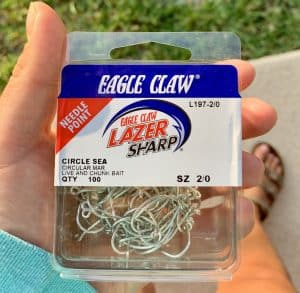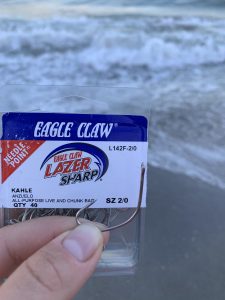The decision to use a Kahle hook or a Circle hook depends on how you're fishing. If you're actively fishing, meaning holding the rod in your hand, Kahle hooks are the way to go. If you're using spiked rods, use Circle hooks.
Some fisherman will say choose circles if you've got a hard bite, and kahles if you have a light bite, but how can we possibly know how hard of a bite we'll get when we're setting up our rig?! We need to make this decision based on how we're fishing, not based on how we think a fish might bite.
Circle Hook Design:
Circle hooks were designed to eliminate a gut hook during catch and release fishing because gut hooks are much more likely to kill a fish in comparison with a mouth hook. A mouth hook is very easy to remove with minimal damage to the fish. Anglers should always take steps towards preserving the life of a fish they don't intend to keep in order to help protect the population. Circle hooks are characterized by a wide gap and an inward pointed tip. The tip typically points directly perpendicular to the shaft. At first glance, it may seem that circle hooks would be unlikely to successfully hook a fish, but they have proven to be extremely effective hooks.
The inward pointed tip allows for the hook to be swallowed with the bait, but not hooked in the stomach. As the fish swims away and turns, the hook comes back up, re-enters the mouth, and turns out the side of the mouth. As soon as the turned hook reaches the mouth, fish on! Read our other article about the Best Hook for Catch and Release fishing.

Contrary to other fishing methods, a circle hook must not be set by the fisherman. The fish effectively hooks itself when the line is tight and the hook turns in the mouth. This is why circle hooks are best used in conjunction with spiked rods. Simply cast your line, drop your rod in your sand spike, eliminate the slack in the line and keep the drag a little tight. The key is eliminating the slack in the line. It's very hard to ensure the proper hook rotation in the mouth if the line isn't tight.
If you try to set a circle hook, you're actually making it harder on yourself because of the likelihood that you'll rip the circle hook right out of the fish's mouth. That being said, we all know habits are hard to break and some fisherman tend to actively set the hook out of habit. If this is you, and you're actively holding the rod, its time to choose the kahle hook.
Circle Hook Tips:
One drawback to using circle hooks is putting the bait on. With the inward pointed tip, it can be challenging to work the bait on. Some fishermen recommend holding the circle hook right at the bend to make baiting easier. If this is difficult for you, I'd encourage you to practice and see if you can get the hang of it.
Resist the urge to bend the circle hook to make it easier to bait. This will defeat the purpose of a circle hook and make it more difficult for the circle hook to work as designed.
When removing the circle hook from the fish's mouth, simply turn the hook and pull it out. You may find that crimping the barb after baiting makes this significantly easier. Try this with awareness, though, as the barb serves a purpose to decrease the possibility of losing a fish after hooking. Crimping the barb effectively eliminates the barb, thereby minimizing barb functionality.
Some other tips for circle hook use include pairing a circle hook with a flexible rod, and using a light sinker which will allow the fish to pull it along the bottom and create the tension necessary to set the hook.
Kahle Hook Design:
Kahle hooks differ from Circle hooks primarily in the orientation of the tip. Instead of pointing directly inward, the tip of a Kahle (pronounced like Kale) hook points a little more up. To describe it best, I'd say it looks like the tip of a circle hook was kind of pulled up and out to create more distance between he shaft and the tip. The Kahle hook was designed to improve upon some of the disadvantages of circle hooks and J hooks. J hooks cause too many gut hooks, and circle hooks can be difficult to bait. A Kahle hook still minimizes gut hooks (although not quite as well as a circle hook), and makes it easier, in comparison with a circle, to bait live or chunk bait. Kahle hooks are also known as “live bait hooks” because of this.

Kahle Hook Tips:
With Kahle hooks, the fisherman can choose not to actively set the hook, similar to how a circle hook operates, and still succeed in hooking a fish. Some fishermen enjoy setting the hook though, and that's where the Kahle hook can surpass a circle. If you're holding the rod and wanting to actively set the hook, but also not wanting to get a gut hook, a Kahle hook is the choice for you.
Kahle hooks tend to hook fish deeper than a circle hook would. For this reason, Kahle hooks are not intended for use when catch and release fishing.
Specific Product Recommendations
For circle hooks, since the mechanism works with consistent tension from a tight line combined with the fish swimming away, a sharp tip is key. We recommend using an Eagle Claw Lazer Sharp circle hook as they come in the package already very sharp and are American made. They will dull overtime though, so pick up a whetstone sharpener to keep the hook sharp in between fishing trips.
Similar statements can be made about Kahle hooks. We recommend using an American made product, such as Eagle Claw Lazer Sharp, or TroKar hooks. Always keep your hooks sharp with a sharpener!
Tight lines & high tides, y'all!
As an Amazon Associate I earn from qualifying purchases.
Recent Posts
Fat Cow Jig Strips: The Ultimate Bucktail Jig Upgrade for Surf Fishing
As discussed in my previous article, "Surf Fishing with Bucktail Jigs: Ultimate Guide for Beach Anglers," bucktail jigs are a staple in any surf angler's tackle box, offering a versatile way to catch...
In my previous article, "Surf Fishing with Bucktail Jigs: Ultimate Guide for Beach Anglers," I introduced you to the bucktail jig and discussed how versatile of a lure it is for catching a wide range...
